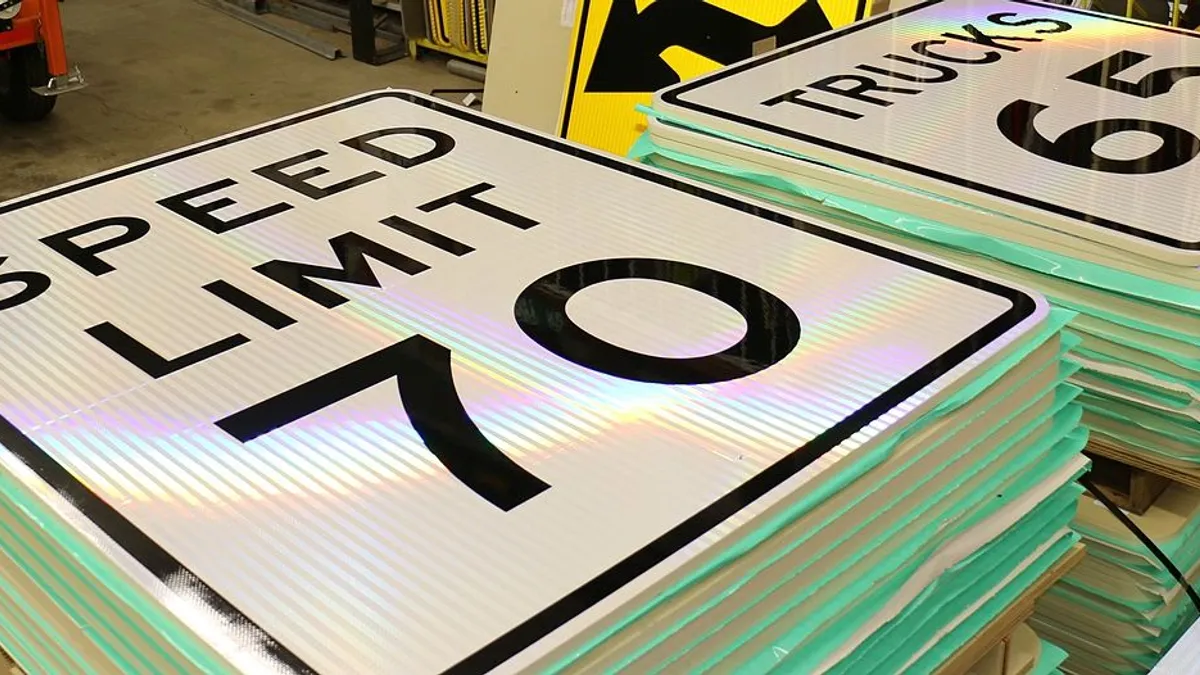Dive Brief:
- The National Association of City Transportation Officials (NACTO) last week released a guide urging local leaders to rethink how they set speed limits on city streets in a bid to prevent pedestrian deaths.
- The guide, entitled "City Limits," says cities should consider setting default speed limits on many streets at once, designate slow zones in what they deem "sensitive areas" and set speed limits on major corridors by using studies that take into account density and activity level.
- Those changes would represent a major shift from the traditional way of setting speed limits, which involves measuring 100 drivers traveling without traffic and setting the speed limit based on the 15th-fastest driver. That practice is known as the 85th percentile, which NACTO Program Manager Jenny O'Connell described in a statement as "an oversimplified and outdated method."
Dive Insight:
The guide comes as pedestrian fatalities continue to climb in the United States, painting a gloomy picture about the safety of roadways nationwide. Many traffic safety advocates blame a lack of secure road crossings, poor lighting at night and unsafe driving behaviors like speeding and distracted driving for the continued rise in fatalities.
NACTO is calling for a major policy shift away from the 85th percentile method, which came to prominence in transportation planning in the 1940s. The 85th percentile method worked on the basis that drivers act responsibly at all times based on research at the time, but it is no longer appropriate, O’Connell told Smart Cities Dive in an interview.
"That was based on an assumption that drivers act rationally and prudently and know how fast to go for the street conditions," O'Connell said. "And that's a flawed assumption. Drivers make decisions based on a lot of cues around them, and those cues aren't always based fully in rationality."
The novel coronavirus pandemic (COVID-19) has amplified those concerns about drivers' speeding. As congestion has dropped nationwide under stay-at-home orders, some cities have seen average speeds climb rapidly as those left on the roads have less concerns about driving slowly. During the week of March 13 to March 30, Los Angeles drivers, for example, increased their speeds up to 75% on average within a week.
NACTO hopes to take a more holistic approach to speed limit designation that allows planners to account for the needs of pedestrians, bicyclists and transit riders. That echoes a movement in many cities to reconsider how street space is allocated and designed post-COVID-19, especially as many have dabbled with closing streets to traffic altogether.
The changes also shine a light on the racial inequities present in American cities, which have been highlighted in recent months by the nationwide protests for racial justice. O'Connell noted the dangers of police stops for Black and Latinx drivers, who are often also subject to more stop-and-searches than White drivers and can be subject to negative interactions with the police. And she said there is other research that shows, for example, that drivers may be less inclined to stop for a person of color crossing the street than a White person.
But often, she said, cities rely on their police departments to enforce speed limits and encourage safer driving, rather than look at how areas like street design and policies like speed limits can instead have the same effect. "When we look at making our streets safer, we have to look at all the ways our streets are dangerous, rather than looking at each of these things in a silo," O'Connell said.
Other groups including Transportation for America have called for cities to focus less on how quickly cars can move along their streets, which in turn can create more congestion, and instead think about how streets can be accessible to every user. Such policy shifts to reduce speeds and enhance safety are starting to take root in various cities.
"A safe street is not one where safety is determined by how fast someone can comfortably drive, but rather one where a person can comfortably walk, ride a bike, and cross the street using a wheelchair," Ryan Noles, senior transportation planner for the City of Boulder, CO said in a statement released by NACTO.












